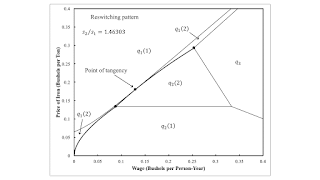In 1929, John Maynard Keynes and Hubert D. Henderson wrote, Can Lloyd George Do It? The Pledge Examined. This was published by The Nation and Athenaeum and is an examination of the pledge by the leader of the Liberal party, if elected, to dramatically reduce the amount of unemployment in Great Britain. (I was inspired to look up this work while reading Zachary Carter's new book.)
Chapter VI of Keynes and Henderson is concerned with "How Much Employment Will the Liberal Plan Provide?" The direct employment for each million pounds can be quantified. The authors divide the resulting indirect employment into two types. The first, in the industries that directly and indirectly supply road-building, housing, and so on, Keynes and Henderson think can be quantified:
VI.2 The Importance of Indirect Employment"...There is nothing fanciful or fine-spun about the proposition that the construction of roads entails a demand for road materials, which entails a demand for labour and also for other commodities, which, in their turn, entail a demand for labour. Such reactions are of the very essence of the industrial process. Why, the first step towards a right understanding of the economic world is to realise how far-reaching such reactions are, to appreciate how vast is the range of trades and occupations which contribute to the production of the commonest commodities. That a demand for a suit of clothes implies a demand for yarns and tops, and so for wool; that the services of farmers, merchants, engineers, miners, transport workers, clerks, are all involved - this is the A B C of economic science...
Generally speaking, the indirect employment which schemes of capital expenditure would entail is far larger than the direct employment. This fact is one of the strongest arguments for pressing forward with such schemes; for it means that the greater part of the employment they would provide would be spread far and wide over the industries of the country. But the fact that the indirect employment would be spread far and wide does not mean that it is in the least doubtful or illusory. On the contrary, it is calculable within fairly precise limits..."
The second type of indirect employment results from the multiplier effects on aggregate demand of an increase in government spending. At this time, Keynes did not think these indirect effects could be estimated ahead of time, even though he considered them of immense importance:
VI.3 The Cumulative Force of Trade Activity"But this is not the whole of the story. In addition to the indirect employment with which we have been dealing, a policy of development would promote employment in other ways. The fact that many workpeople who are now unemployed would be receiving wages instead of unemployment pay would mean an increase in effective purchasing power which would give a general stimulus to trade. Moreover, the greater trade activity would make for further trade activity; for the forces of prosperity, like those of trade depression, work with a cumulative effect. When trade is slack there is a tendency to postpone placing orders, a reluctance to lay in stocks, a general hesitation to go forward or to take risks. When, on the other hand, the wheels of trade begin to move briskly the opposite set of forces comes into play, a mood favourable to enterprise and capital spreads through the business community, and the expansion of trade gains accordingly a gathering momentum.
It is not possible to measure effects of this character with any sort of precision, and little or no account of them is, therefore, taken in 'We Can Conquer Unemployment." But, in our opinion, these effects are of immense importance. For this reason we believe that the effects on employment of a given capital expenditure would be far larger than the Liberal pamphlet assumes. These considerations have a bearing, it should be observed, on the time factor in Mr. Lloyd George's pledge. It is a mistake to suppose that a long interval would elapse after, let us say, the work of road construction had been commenced before the full effect on employment would be produced. In the the economic world, 'coming events cast their shadows before,' and the knowledge that large schemes of work were being undertaken would give an immediat fillip to the whole trade and industry of the country."
It would take the work, a few years later, of Richard Kahn and James Meade to formalize these indirect effects and show how to quantify them, in terms of the marginal propensity to consume.














